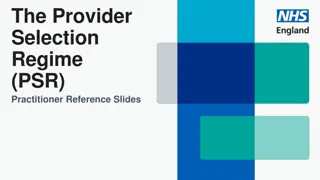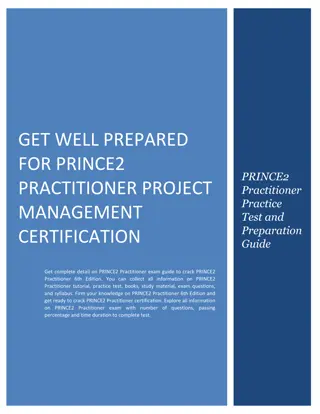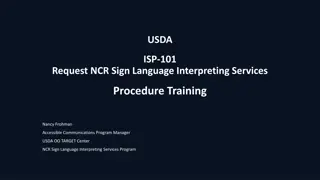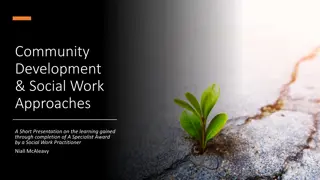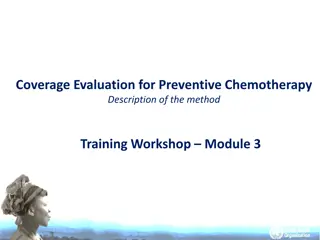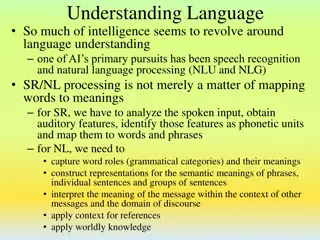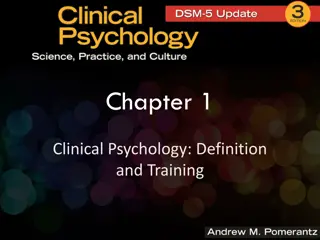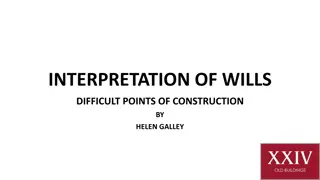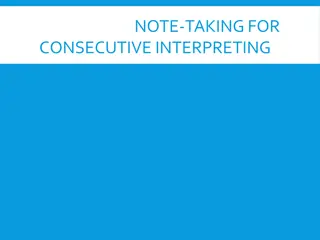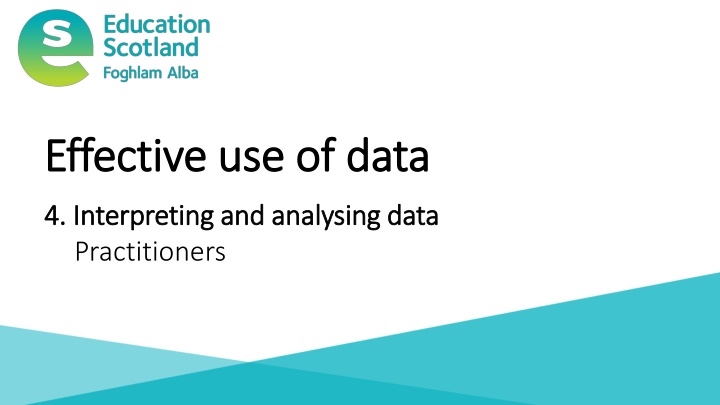
Effective Data Interpretation and Analysis for Professional Learning
Explore national guidance and research on using data, interpreting different types of data, and utilizing comparator data in education settings. Enhance your career-long professional learning through effective data analysis practices.
Download Presentation

Please find below an Image/Link to download the presentation.
The content on the website is provided AS IS for your information and personal use only. It may not be sold, licensed, or shared on other websites without obtaining consent from the author. If you encounter any issues during the download, it is possible that the publisher has removed the file from their server.
You are allowed to download the files provided on this website for personal or commercial use, subject to the condition that they are used lawfully. All files are the property of their respective owners.
The content on the website is provided AS IS for your information and personal use only. It may not be sold, licensed, or shared on other websites without obtaining consent from the author.
E N D
Presentation Transcript
Effective use of data Effective use of data 4. Interpreting and analysing data 4. Interpreting and analysing data Practitioners
The national model of professional learning The national model of professional learning The national model of professional learning | Professional Learning | Education Scotland
Draft Group Agreement and Protocols Draft Group Agreement and Protocols Work together learn from, with, and on behalf of each other create a safe space to share ideas and build learning agree that everyone is an equal and valued participant remain in the room (emails and phone protocol).
Connector In groups/pairs: Share the job you thought you might do when you were a child/teenager?
Re Re- -cap cap In workshop 1 we looked at the purpose and use of data including: the meaning of data and evidence, the ways in which data is used and what we mean by big and small data. In workshop 2 we considered different categories of data and how these may be intersected to support improvement. In workshop 3 we examined how we create effective systems and processes
Aims Aims In this workshop we will consider: national guidance and research including signposting to national data sets questions to explore when analysing and interpreting data the use of comparator data, and how to use a data analysis to inform next steps.
Content coverage National guidance and research Using data Getting started Interpreting the data Comparator data
GTCS GTCS Standards for Full Registration and Career Standards for Full Registration and Career Long Professional Learning Long Professional Learning Curriculum and Pedagogy 3.1.1 - Plan effectively to meet learners needs 3.1.4 - Effectively employ assessment, evaluate progress, recording and reporting as an integral part of the teaching process to support and enhance learning. Professional Learning 3.3.2 - Engage in reflective practice to develop and advance career-long professional learning. GTCS The Standard for Full Registration GTCS - The Standard for Career-Long Professional Learning
HGIOS 4 Staff make effective use of current available data on levels of child poverty and apply this to ensure equity (1.5) All teachers have well-developed skills of data analysis which are focused on improvement (2.3) We use data to evaluate the effectiveness of interventions designed to improve outcomes for all learners (2.3)
Rapid Evidence Review Paper Rapid Evidence Review Paper Section four of the Education Scotland Rapid Evidence Review on interpreting and analysing data highlights the points below. Educators often report a lack of confidence in being able to interpret data. Educators should be familiar with a range of key measures and measures should be embedded into improvement plans. Educators should gather and analyse improvement data frequently and look for patterns, trends and variation. It is important to intersect data and evidence to understand why a pattern, trend or gap exists. Schools and settings should utilise local and national comparator data.
Using data Using data Data analysis involves examining information and breaking it down for understanding and meaning. To analyse data effectively educators should be confident in: o reading and interpreting a range of common tables, charts and diagrams, and oanalysing and utilising the information gathered to inform improvement.
Reflection activity Reflection activity Using data is not separate from planning and from routine decisions in schools. Instead, data is a necessary part of an ongoing process of analysis, insight, new learning and changes in practice. (Lorna M Earl and Steven Katz, 2009) How confident do we feel when it comes to analysing data? What school / classroom level data do we currently analyse? How do we currently utilise this data to inform improvement?
How do we start to analyse data? How do we start to analyse data? Key questions to ask: What do we wish to explore or find out? Which data sets will help us to do this? Is the data we plan to look at easily available and reliable?
What are we looking for? What are we looking for? Examples: evidence of progress/ lack of progress surprising outcomes/anomalies (good and bad) patterns or trends emerging over time gaps in attainment the impact of a change we have implemented to make comparisons in relation to local/national data.
Using attainment data Using attainment data What are we looking for? Examples pattern There is under attainment of EAL boys in writing in most year groups. The attainment gap between SIMD Q1 and SIMD Q5 in the current P4 has increased for the past three years (P2 15%, P3 20%, P4 22%) trend anomaly Girls are outperforming boys in all year groups in reading apart from P5. gap There is a 20% gap between P4, SIMD Q1 learners and SIMD Q5 learners in numeracy.
Which data sets will help us do this? Which data sets will help us do this? Examples: class/setting checklists or spreadsheets establishment tracking files (if available) local authority tracking tools (if available) national data tools, e.g. ACEL data, Insight data(secondary), BGE benchmarking tool.
Using contextual information Using contextual information Key demographic groups (boys, girls, English as an Additional Language (EAL), ASN, SIMD Q1 etc) Attendance and mobility How many learners are living in areas of disadvantage? Who are the significant demographic groups of learners within your context? What is the cohort attendance? What is the attendance of different demographic groups? What is the demographic profile of different cohorts? What stands out (i.e. because there is an imbalance or particularly large numbers of X)? What implications might this data have for learning and teaching? Consider: o Understanding needs o Developing relationships o Attainment and achievement including pedagogical approaches or curriculum offer What key questions might you ask? Consider Analyse Understand
Using attainment data Using attainment data part 2 part 2 The attainment of cohorts and key demographic groups in different subject areas. How groups compare to each other and local/national comparators. The attainment of learners living in the areas of deprivation (SIMD Q1) against those living in the least deprived areas (SIMD Q5). Attainment in each subject and cohort. Any trends, patterns, gaps or anomalies between groups of learners / subjects / cohorts. Think about: Boys, girls, SIMD Q1, FSM, EAL, BME, ASN, CE etc. How cohort compares to national / local groups. Understand Are there any gaps between a specific group of learners and all learners in your class? What is the poverty related attainment gap in subjects and cohorts? Are any one group doing particularly well? Above expected expectations? How does your whole class or cohort compare to the overall school picture, national or LA cohorts? Which groups of learners are most at risk of underachievement for their age and stage? Are learners on track to meet their predictions? Which groups may need to be supported to make rapid or accelerated progress? Consider Analyse
Availability and reliability Availability and reliability try to keep ongoing records e.g. assessment results find out what data tools the local authority have available triangulate data one source is unlikely to give you the full story look outwards how does the data compare to local and national data?
Digital tools Digital tools Example tools: Microsoft Excel/ Google Sheets Microsoft Forms/ Google Forms Power BI Graphs e.g. bar, line, scatter, etc How to sort and filter your data in excel Power BI Tutorial for Beginners
Analysing the data Analysing the data Data for illustrative purposes only
Observational/ Observational/s statistical tatistical interpretation of data interpretation of data Examples: Child A and Child D s results have continued to decline. Has there been a change in e.g. attendance, behaviour, confidence etc? How does this compare to other curricular assessments? Child B, H, I, K & M s results are lower than the rest of the cohort. We notice that these children are all EAL children. Child J has a steady positive increase in their results. What could have impacted this change?
Intersecting data Intersecting data Once data has been analysed, it is important to consider why a gap, pattern or a trend may exist. The next step may be to intersect different categories of data as, outlined in workshop 2, to understand why.
Observational/statistical interpretation of data Observational/statistical interpretation of data Example: You have a P3 class and you have identified from your assessments and observations that there is an attainment gap between boys and girls in reading. You can see from tracking data that males are not progressing in first level as well as their female peers. Observational data would suggest that they don't read for enjoyment. You carry out a pupil voice survey and it confirms that that males don't enjoy reading in class or at home. You decide to try test of change, using a Plan/Do/Study/Act (PDSA)* cycle. You will introduce some new genres and texts into the class library such as comic's and books of interest which pupils have suggested etc. continued on next slide *https://learn.nes.nhs.scot/2274/quality-improvement-zone/qi-tools/pdsa
Observational/statistical interpretation of data Observational/statistical interpretation of data Example continued: You introduce some new texts to the class library/resources and you will track reading engagement with all pupils (with particular interest in the males) over the next 2 months. Based on the data and pupil voice you can see whether this has been successful and can be adopted or if a new theory can be tested. Model for Improvement
Local examples of data Local examples of data tables, charts, graphs tables, charts, graphs This slide is a place holder for facilitators to consider adding in any local authority examples of data. This slide can be added to or removed as appropriate.
Analysing attainment data Analysing attainment data - - summary summary Look for attainment gaps in subjects, cohorts, across the whole school and/or within specific demographic groups. Identify groups of learners who are working below expected standards and highlight those who are showing particularly good progress. Explore whether common trends or patterns are present within your school. Consider progress against local and national comparators and use this information when considering expectations, target setting or collaborating with other schools/settings. Identify a starting point for understanding why a pattern, trend or a gap exists.
Making data comparisons Making data comparisons Why? What do we compare? What are the benefits? to self-evaluate to make better informed decisions to identify trends, similarities and differences to improve standards to support the interrogation, interpretation and analysis of data for improvement supports moderation process and encourages reflection highlights best practice can encourage collaboration across settings can encourage further exploration previous cohorts year on year data stage partners within our own school local authority comparator schools national comparator schools
Using nationally available comparator data Using nationally available comparator data Attainment data can be compared against national or local authority data sets. There are nationally available improvement tools, such as the BGE Benchmarking tool or Insight which have been created to support schools to make comparisons out with their own establishment. In these tools a virtual comparator is created using learners from others schools with similar characteristics e.g. SIMD, ASN, Gender. Virtual comparator values are included to provide context for the data. o A virtual comparator is a sample group of pupils from other parts of Scotland who have similar characteristics to the young people in the school (e.g. matched on gender, additional support needs, stage and the social context in which they live).
Comparator data within and across schools Comparator data within and across schools and settings and settings Comparisons can also be made within settings and across settings in order to: support self-evaluation, improve standards, support the interrogation, interpretation and analysis of data. Data can be used to compare cohorts and attainment and progress over time. Comparisons can also be made with stage partners within schools and departments, as part of moderation processes, and also with other local authority groupings.
Comparator data within and across schools and settings Comparator data within and across schools and settings - - part 2 part 2 Comparisons can also be made between big data and small data, as outlined in workshop 1 This may involve practitioners exploring whether whole school patterns, trends and gaps are reflected in class level data.
Reflect Reflect What do you compare when analysing data to review the progress of learners? How does this inform our teacher professional judgements? How confident do you feel when using comparator data?
Aims Review Aims Review In this workshop we will consider: national guidance and research including signposting to national data sets questions to explore when analysing and interpreting data the use of comparator data, and how to use a data analysis to inform next steps.
Reflection Activity Reflection Activity TASK How confident do we feel effectively analysing data? What key messages or actions have you taken from the workshop? What might you do differently in school?
Feedback Feedback Insert you own evaluation code here



